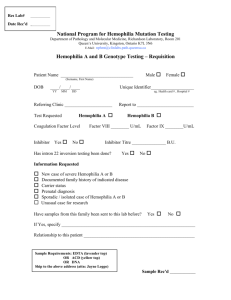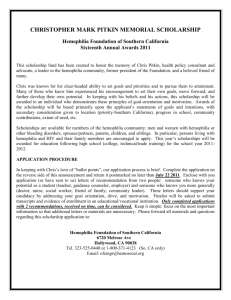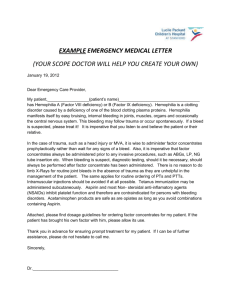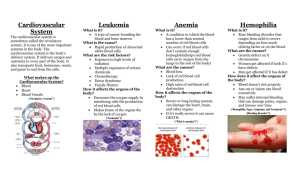An Essay on the Status of Hemophilia Care in
advertisement
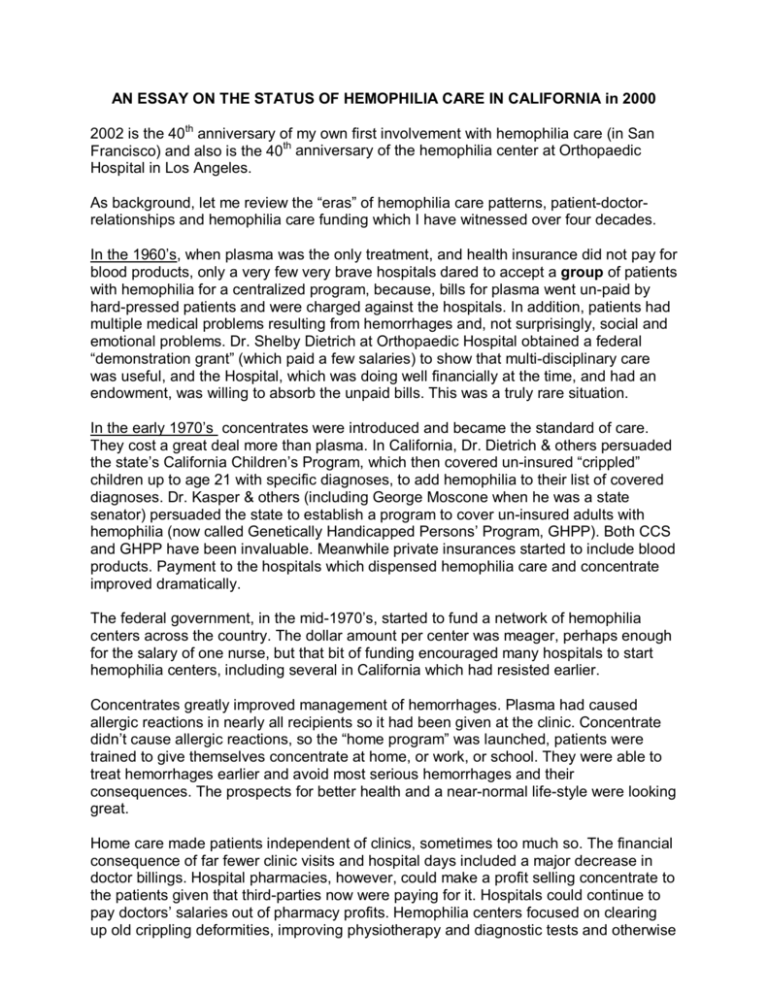
AN ESSAY ON THE STATUS OF HEMOPHILIA CARE IN CALIFORNIA in 2000 2002 is the 40th anniversary of my own first involvement with hemophilia care (in San Francisco) and also is the 40th anniversary of the hemophilia center at Orthopaedic Hospital in Los Angeles. As background, let me review the “eras” of hemophilia care patterns, patient-doctorrelationships and hemophilia care funding which I have witnessed over four decades. In the 1960’s, when plasma was the only treatment, and health insurance did not pay for blood products, only a very few very brave hospitals dared to accept a group of patients with hemophilia for a centralized program, because, bills for plasma went un-paid by hard-pressed patients and were charged against the hospitals. In addition, patients had multiple medical problems resulting from hemorrhages and, not surprisingly, social and emotional problems. Dr. Shelby Dietrich at Orthopaedic Hospital obtained a federal “demonstration grant” (which paid a few salaries) to show that multi-disciplinary care was useful, and the Hospital, which was doing well financially at the time, and had an endowment, was willing to absorb the unpaid bills. This was a truly rare situation. In the early 1970’s concentrates were introduced and became the standard of care. They cost a great deal more than plasma. In California, Dr. Dietrich & others persuaded the state’s California Children’s Program, which then covered un-insured “crippled” children up to age 21 with specific diagnoses, to add hemophilia to their list of covered diagnoses. Dr. Kasper & others (including George Moscone when he was a state senator) persuaded the state to establish a program to cover un-insured adults with hemophilia (now called Genetically Handicapped Persons’ Program, GHPP). Both CCS and GHPP have been invaluable. Meanwhile private insurances started to include blood products. Payment to the hospitals which dispensed hemophilia care and concentrate improved dramatically. The federal government, in the mid-1970’s, started to fund a network of hemophilia centers across the country. The dollar amount per center was meager, perhaps enough for the salary of one nurse, but that bit of funding encouraged many hospitals to start hemophilia centers, including several in California which had resisted earlier. Concentrates greatly improved management of hemorrhages. Plasma had caused allergic reactions in nearly all recipients so it had been given at the clinic. Concentrate didn’t cause allergic reactions, so the “home program” was launched, patients were trained to give themselves concentrate at home, or work, or school. They were able to treat hemorrhages earlier and avoid most serious hemorrhages and their consequences. The prospects for better health and a near-normal life-style were looking great. Home care made patients independent of clinics, sometimes too much so. The financial consequence of far fewer clinic visits and hospital days included a major decrease in doctor billings. Hospital pharmacies, however, could make a profit selling concentrate to the patients given that third-parties now were paying for it. Hospitals could continue to pay doctors’ salaries out of pharmacy profits. Hemophilia centers focused on clearing up old crippling deformities, improving physiotherapy and diagnostic tests and otherwise optimizing patient health and education. Many of their useful activities were not “billable” to insurance companies but it didn’t matter at the time. In the early 1980’s, the catastrophe of AIDS appeared, and, after the initial shock, many patients and families became enraged. Their anger and blame was directed primarily against pharmaceutical companies but also against doctors and hemophilia centers. Center personnel were learning to manage a new devastating disease with frequent deaths, and simultaneously trying to deal with patient anger and lawsuits. By the time the disease was known to be transmitted by blood (Dec 1982), a majority of hemophilia patients already had been infected. Within a little over two years, the virus was identified, a blood test was developed and concentrate was viral-inactivated. The last HIV sero-conversion in a southern California hemophilia patient was in early 1985. The response to the epidemic had been incredibly fast but the damage already had been done. At the very same time, the financial underpinning of the centers was being undermined by a new entity, the home-care pharmacy. Starting in Rialto Pharmacy in Riverside County, entrepreneurial pharmacists realized that great profits were to be made from specializing in selling concentrate. Patients had the legal freedom to take concentrate prescriptions to any pharmacy, they were not obliged to use hospital pharmacies. Home care companies could afford to deliver the concentrate to the patient’s home and also give him handsome rewards (e.g. free trips) in return for his lucrative business. At one point, I had data showing that one home-care company made a gross profit of over $30,000 for each year’s worth of concentrate sold to each patient with severe hemophilia in one town. The services provided to the patient cost less than $5000. The patients enjoyed the services and rewards (which could not be duplicated, legally, by hospital pharmacies) and were easily recruited to home care pharmacies. Hospital pharmacies no longer made enough profit on their remaining business to support the salaries of hemophilia center staff. And, at the same time, traditional insurance turned into HMOs, PPOs etc, the major purpose of which was to conserve money by restricting care. We devoted huge amounts of (un-reimbursed) staff time to trying to get authorizations for the care of our patients, e.g. to have orthopedic surgery by an experienced surgeon with the support of an experienced team, rather than in a totally-inexperienced setting. In the 1990’s the treatment of AIDS improved and long-term survival became commonplace. The atmosphere of blame and lawsuits was intense at the beginning of the decade and began to fade at the end. Hemophilia centers suffered increasing financial difficulty. The response was to freeze salaries, cut staff and take on other disease entities (thrombosis, sickle cell disease), none of which paid well. Wherever possible, doctors spent increasing amounts of time in oncology, which was still decently paid. Doctors not interested in oncology joined pharmaceutical companies in various capacities. Searches for young doctors to replace retiring or deceased ones were difficult. A few hemophilia centers in California were under the de-facto control of a nurse, while doctors are busy elsewhere. No-one asked any more, “how can we improve care?” but rather, “can we survive?” As of 2002, the methods of diagnosing and treating hemophilia and avoiding viral infections are excellent. Home care companies are very strong and command the market. They donate generously to local hemophilia foundations, which are patient groups. Through these contacts they solicit new patients. Hemophilia centers are barely holding on. They usually lose money for their parent institutions, which now regard such centers as negatively as they did in the 1960’s. The Future Hemophilia foundations are financed well. They strongly believe that gene therapy will be the salvation of persons with hemophilia and put their research donations into that strategy. As one of the remaining hemophilia specialists, an elder-stateswoman, although semiretired, I offer my own opinion on hemophilia centers. I have asked myself, are they needed? Should we say to the patients, just go to your beloved home care companies for everything? (It’s tempting!) Home care companies have not developed coagulation diagnostic facilities and experts, nor pediatricians, internists, physiotherapists, orthopedic surgeons etc familiar with the management of hemophilia. (At our center, we go through a long check-list in preparation for a surgical operation, which I believe to be the secret of our outstanding success in orthopedic surgery for hemophilia.) It would be a shame to lose what has been developed, but it’s sliding down the hillside right now. What could be done to save hemophilia centers? (1) The federal government is being implored to increase funding per center. Success is not likely. (2) I’d love to see support for young doctors interested in coagulation, consisting of financial support for specialized fellowships in coagulation, financial help with their research projects in coagulation, small get-acquainted meetings for them with senior coagulation specialists to find mentors and ideas for research projects. It also would be necessary to consider how their salaries would be supported were they to go into coagulation as a special interest, usually at a teaching institution. (3) A few named professorships (endowed chairs) could be established providing approximately half-support of a faculty position, to help support a few doctors with a strong academic interest in hemophilia and coagulation disorders, with the proviso that the doctor spend at least half-time in that field. (4) More support could be given to further training for the de-facto hemophilia care providers, the nurses of both hemophilia centers and home-care agencies. (The latter could be asked to pay tuition.) Training sessions greatly encourage staff, especially when they bring staff from different centers together and let them share experiences (including crying on each other’s shoulders!) I have been received enthusiastically when I have talked to such groups of nurses. They recognize their own inadequate backgrounds. (5) The government could be lobbied to impose a tax on concentrate sales, to support hemophilia centers. (The average person with hemophilia, including all severities and age groups, used $140,000 of billed health care, mostly concentrate, in 1995, according to a California audit. A one percent tax on that would help centers survive, a two percent tax would let them thrive.) (6) I encourage funding of small local research projects on hemophilia, so that local hematologists, nurses, social workers, physiotherapists, etc., are encouraged to continue or initiate an interest in hemophilia. The government and other large agencies tend to concentrate funding on single projects, e.g. gene therapy, in “centers of excellence”, i.e. big places with lots of scientists in a single area of study. There’s no hope for the individual curious-minded person in a place that isn’t an official center of excellence. These inquiring persons must put their hope in private foundations, usually local ones. (7) I wish I had a dozen more ideas! Addendum as of 2005: Insurance companies and other payors would be well-advised to steer their hemophilia patients to “340-B” pharmacies located at HTCs. Pharmacies attached to governmentfunded HTCs get a special discount on concentrate which is passed on to patients. Profits from concentrate sales help support HTCs. It’s a health-saving, money-saving system.
